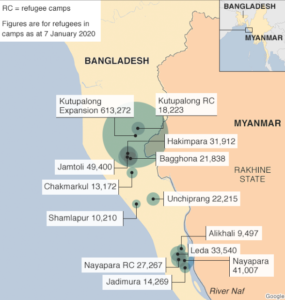In news : During the visit of Indian Prime Minister to Bangladesh, the Prime Minister of Bangladesh requested India, as a member of the UN Security Council, to play a “strong role” in the early repatriation of the displaced Rohingyas back to Myanmar
Who are Rohingyas?
- They are an ethnic group, largely comprising Muslims, who predominantly live in the Western Myanmar province of Rakhine. They speak a dialect of Bengali, as opposed to the commonly spoken Burmese language
- Rohingya Muslims represent the largest percentage of Muslims in Myanmar, with the majority living in Rakhine state.
- They are descendants of Arab traders and other groups who have been in the region for generations.
Language of Rohingyas
- The Rohingya language is part of the Indo-Aryan sub-branch of the greater Indo-European language family and is related to the Chittagonian language spoken in the southernmost part of Bangladesh bordering Myanmar
- Rohingya scholars have written the Rohingya language in various scripts including the Arabic, Hanifi, Urdu, Roman, and Burmese alphabets, where Hanifi is a newly developed alphabet derived from Arabic with the addition of four characters from Latin and Burmese
More about Rohingyas & their migration
- The United Nations Refugee Agency (UNHCR) places them among the “the most vulnerable groups of the forcibly displaced
- Ppukation: Before the displacement crisis in 2017, when over 740,000 fled to Bangladesh, an estimated 1.4 million Rohingya lived in Myanmar
- Main reasons for their migration are: Denial of citizenship, restriction of their movements, education, job and their exploitation by Myanmar military, as reported in the news
Arguments of Rohingyas & Myanmar govt over their origin
Arguments of Rohingyas:
- The Rohingya maintain they are indigenous to western Myanmar with a heritage of over a millennium and influence from the Arabs, Mughals and Portuguese.
- The community claims it is descended from people in precolonial Arakan and colonial Arakan; historically, the region was an independent kingdom between Southeast Asia and the Indian subcontinent.
Arguments of Myanmar govt:
- The Myanmar government considers the Rohingya as colonial and postcolonial migrants from neighbouring Chittagong/East Bengal respectively Bangladesh.
- It argues that a distinct precolonial Muslim population is recognized as Kaman, and that the Rohingya conflate their history with the history of Arakan Muslims in general to advance a separatist agend
Denial of citizenship to Rohingyas
- The government of Myanmar, a predominantly Buddhist country, denies the Rohingya citizenship and even excluded them from the 2014 census, refusing to recognise them as a people
- Myanmar considers them as persons who migrated to their land during the Colonial rule. So, it has not granted Rohingyas full citizenship
- According to the 1982 Burmese citizenship law, a Rohingya (or any ethnic minority) is eligible for citizenship only if he/she provides proof that his/her ancestors have lived in the country prior to 1823. Else, they are classified as “resident foreigners” or as “associate citizens”
- Since they are not citizens, they are not entitled to be part of civil service. Their movements are also restricted within the Rakhine state.
Why did they flee their state?
- The exodus began on 25 August 2017 after Rohingya Arsa militants launched deadly attacks on more than 30 police posts.
- Rohingyas arriving in Bangladesh said they fled after troops, backed by local Buddhist mobs, responded by burning their villages and attacking and killing civilians.
- Hence they migrated to Bangladesh and other neighbouring countries including India
Rohingya refugee sites in Bangladesh

Global response
The mass displacement of Rohingya in 2017 led the International Criminal Court investigating crimes against humanity, and led to the International Court of Justice investigating genocide.
















